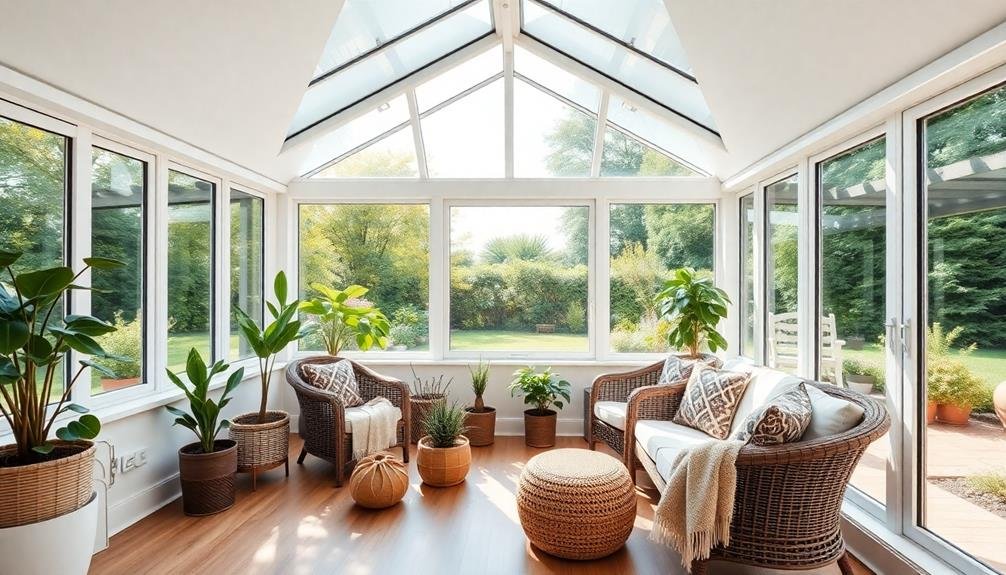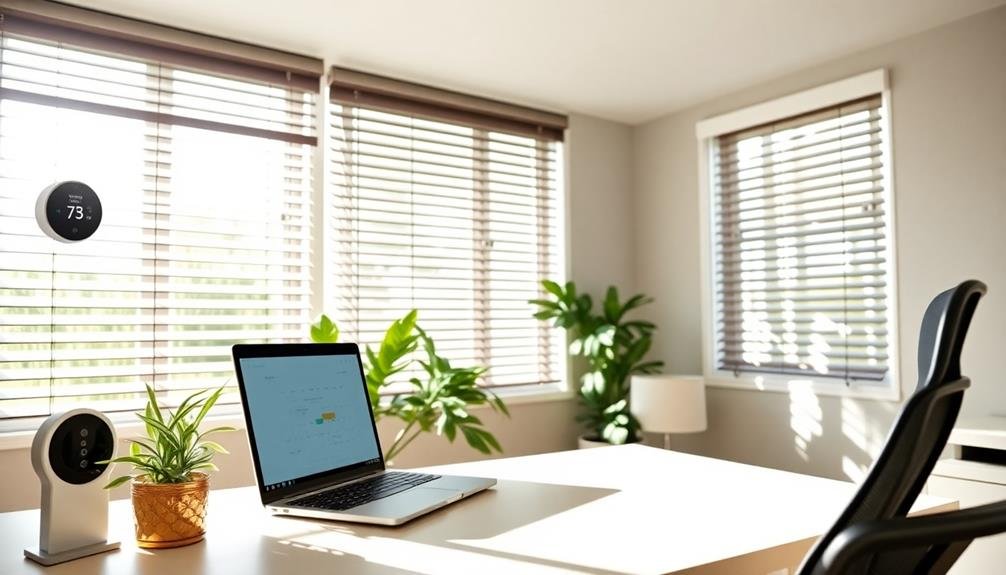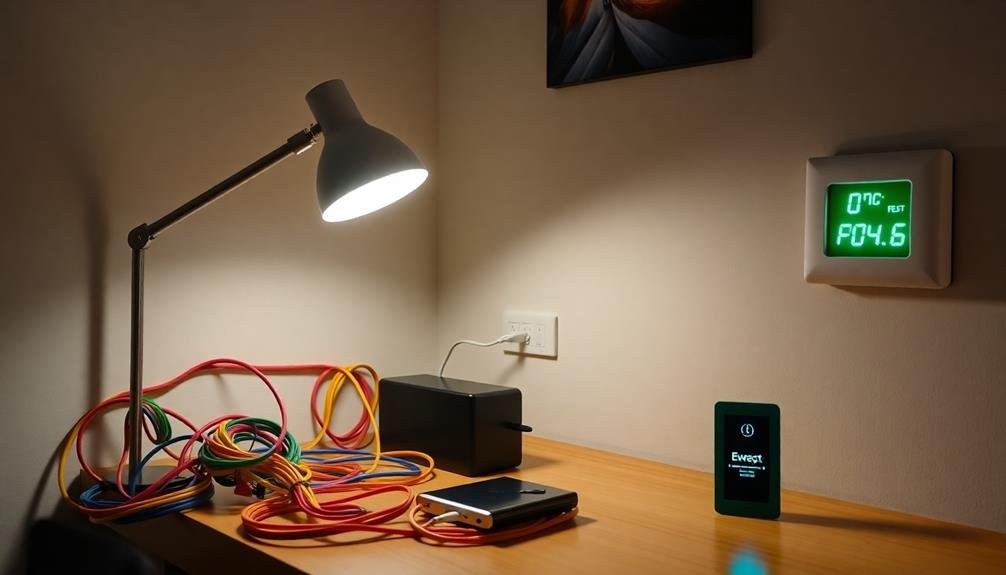Three effective sunspace designs for natural home heating are the attached greenhouse, Trombe wall system, and solarium-style sunroom. An attached greenhouse is a glass-enclosed room on your home's south side, capturing sunlight and converting it to heat. The Trombe wall system uses a thick, dark-colored wall with a glass pane to absorb and radiate heat. A solarium-style sunroom offers a bright, airy space with large windows and thermal mass flooring for efficient heating. Each design provides unique benefits, from year-round plant growth to energy savings and additional living space. Exploring these options can help you find the perfect sunspace solution for your home.
Attached Greenhouse Sunspace

Versatility defines the attached greenhouse sunspace, a popular choice for homeowners seeking to harness solar energy.
You'll find this design adds both functional space and energy efficiency to your home. It's fundamentally a glass-enclosed room attached to the south-facing side of your house, capturing sunlight and converting it into heat.
During sunny days, the sunspace warms up quickly. You can use this heat directly by opening doors or windows between the sunspace and your living area. At night, you'll close these openings to retain warmth in your main living space.
For maximum efficiency, you'll want to incorporate thermal mass materials like concrete, brick, or water containers in your sunspace. These absorb heat during the day and release it slowly at night.
You can use your attached greenhouse sunspace for various purposes. It's an ideal spot for growing plants year-round, creating a relaxing sitting area, or even as an extended living space.
Remember, proper design is essential. You'll need to take into account factors like glazing type, ventilation, and shading to prevent overheating in summer.
With careful planning, you'll enjoy both energy savings and an attractive addition to your home.
Trombe Wall Sunspace System
Mastering passive solar heating, the Trombe wall sunspace system offers a unique approach to home energy efficiency. This design incorporates a thick, dark-colored wall facing south, with a glass pane placed a few inches in front of it. The space between the wall and glass traps solar heat, which is then slowly released into your home.
You'll find that the Trombe wall works by absorbing sunlight during the day and radiating heat at night. The wall's thermal mass, typically made of concrete, brick, or stone, stores heat effectively. Vents at the top and bottom of the wall allow warm air to circulate into your living space.
To maximize the Trombe wall's efficiency, you should consider adding insulated panels or curtains to cover the glass at night, preventing heat loss. You can also incorporate overhangs or deciduous trees to provide shade during summer months, preventing overheating.
While the Trombe wall system requires careful planning and construction, it can considerably reduce your heating costs. It's particularly effective in climates with cold, sunny winters and moderate summers.
Solarium-Style Sunroom Design

A sunbather's dream, the solarium-style sunroom design brings the outdoors inside while maximizing solar heat gain. You'll enjoy a bright, airy space that captures sunlight through large windows or glass walls, often facing south. This design not only provides a comfortable living area but also acts as a natural heat collector for your home.
To optimize your solarium's heating efficiency, you'll want to take into account:
- Thermal mass flooring, like concrete or tile, to absorb and slowly release heat
- Operable windows or vents for temperature control and air circulation
- Insulated glazing to minimize heat loss during colder months
You can enhance your solarium's performance by incorporating adjustable shading devices to prevent overheating in summer. These might include exterior awnings, interior blinds, or even deciduous trees that provide shade in summer but allow sunlight through in winter.
Your solarium can serve multiple purposes, from a cozy reading nook to a vibrant indoor garden.
Frequently Asked Questions
How Much Does It Cost to Install a Sunspace Heating System?
You'll find costs vary widely, ranging from $5,000 to $30,000+. It depends on your home's size, design complexity, and materials used. DIY options can be cheaper, but professional installation guarantees maximum efficiency and performance.
Can Sunspaces Be Retrofitted to Existing Homes?
Yes, you can retrofit sunspaces to existing homes. You'll need to evaluate structural support, proper insulation, and integration with your current heating system. It's often easier to add a sunspace to south-facing walls for ideal sunlight exposure.
What Maintenance Is Required for Sunspace Heating Systems?
You'll need to regularly clean the glass and maintain the structure. Check for leaks, seal gaps, and guarantee proper ventilation. Keep plants healthy if you have them. Lubricate moving parts and inspect fans or vents annually.
Are Sunspaces Effective in All Climate Zones?
Sunspaces aren't equally effective in all climates. You'll find they work best in areas with cold winters and plenty of sunlight. They're less useful in hot, humid regions or places with frequent overcast skies.
How Long Does It Take to See Energy Savings From a Sunspace?
You'll typically see energy savings from your sunspace within the first heating season. However, the exact time can vary based on your climate, sunspace design, and energy usage patterns. You'll notice reduced heating bills fairly quickly.
In Summary
You've now explored three effective sunspace designs for natural home heating. Whether you choose an attached greenhouse, a Trombe wall system, or a solarium-style sunroom, you'll be harnessing the sun's energy to warm your living space. Remember, each design has its unique benefits and considerations. By implementing one of these eco-friendly options, you're not only reducing your carbon footprint but also creating a cozy, sun-filled area to enjoy year-round. It's time to embrace solar heating!





Leave a Reply